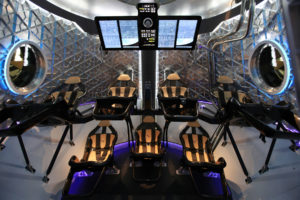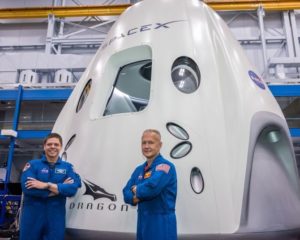Mar
10
SpaceX Crew Dragon’s Successful Test Flight
“[The Commercial Crew Program] is one step closer to launching American astronauts on American rockets from American soil.” — NASA administrator Jim Bridenstine
In Aug. 2016, I wrote about SpaceX’s repeated missions carrying cargo back-and-forth between Earth and the International Space Station (ISS) with its Dragon capsule. I also mentioned SpaceX’s plans for future manned missions. Then, in Mar. 2017, I told you about the Dragon’s historic use of Cape Canaveral’s Launch Complex 39A and the Falcon 9 rocket’s first successful daytime flip of its first stage booster and return flight for landing at the cape. (Unfortunately, Elon Musk later announced that they had to suspend development of the “propulsive landing”, so future landings would be the familiar parachuted splashdown type.)
This week, SpaceX was in the news again with yet another milestone… or two. On March 2nd, the new designed-for-crew capsule (aka Crew Dragon) launched on its first test flight. The following day, “[i]t docked autonomously under the station astronauts’ watchful eyes, instead of relying on the station’s robot arm for berthing.” Applause and whoops of joy echoed from SpaceX’s HQ in Hawthorne, CA, to NASA’s Kennedy Space Center in Cape Canaveral, FL.
Of course, there were no occupants of the capsule to greet station personnel this time — unless you count “Ripley”, a space-suited, instrumental test-dummy named after the heroine of the “Alien” film franchise. It (she?) was “fitted with sensors around the head, neck and spine to record everything an astronaut would experience throughout the mission,” wrote NASA’s Anna Heiney. The capsule itself has similar sensory equipment “to measure noise, vibration and stresses, and to monitor the life-support, propulsion and other critical systems throughout the flight.”
Current ISS crew, including U.S. astronaut Anne McClain and Canadian astronaut David Saint-Jacques, unloaded 400 lbs. of test equipment (including Ripley) from Crew Dragon — I wonder if they strap packing crates in those comfy chairs — before inspecting the capsule and testing its air quality.
Following its 5-day “Demo-1” (or DM-1) mission at the ISS, the 16-foot-tall Crew Dragon autonomously detached itself early Friday morning and returned to Earth, splashing right on time into the Atlantic about 200 miles off the Florida coast. Thus marks another successful mission for Elon Musk’s SpaceX and an important step in returning the U.S. to the business of manned space flights.
Analysts from SpaceX and NASA are now assessing Crew Dragon’s performance and inspecting for possible damage from the launch and re-entry. Barring any serious “issues” (which are not uncommon), NASA astronauts Doug Hurley and Bob Behnken are scheduled to be the first humans delivered to the ISS via Crew Dragon, perhaps as early as this June or July. This is referred to as the “Demo-2” (or DM-2) mission.
“Such a mission would end the decadelong US reliance on Russia for human spaceflight. The US space shuttle program ended in 2011, and NASA has paid Russia about $80 million per seat to send American astronauts to space aboard Soyuz rockets. Those contracts are set to run out this year.” (Theresa Waldrop and Jackie Wattles, CNN)
No more (over)paying an opposing world power for “space taxi” service? That would be, as they say, a “good thing”.

















